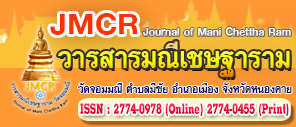A STUDY OF MANAGEMENT COMPONENTS TO ENHANCE PUBLIC RELATIONS IN VOCATIONAL EDUCATION INSTITUTIONS
Keywords:
Management Components, Public Relations, Vocational Education InstitutionsAbstract
This research aimed to: 1) study the management components to enhance public relations in vocational education institutions, 2) synthesize the management components to enhance public relations in vocational education institutions, and 3) validate the management components to enhance public relations in vocational education institutions. This study employed a mixed methodology. Data were collected from academic journals, theses, research reports, textbooks, and related documents. Subsequently, a questionnaire was developed to validate the components by nine selected experts. The data were analyzed using mean and standard deviation.
The results revealed four key management components. 1) Evaluation and Social Responsibility, rated as the most appropriate (mean = 4.42), included sub-components such as performance evaluation, transparency, social impact assessment, and sustainable development. 2) Strategic Planning and Management (mean = 4.28) encompassed goal setting, stakeholder analysis, resource allocation, and indicator development. 3) Content Development and Digital Technology (mean = 4.06) focused on AI application, selection of communication channels, and data analytics. And 4) Engagement and Networking (mean = 4.00) emphasized collaboration with communities and partners.
These four components were found to be integrated and interdependent, with strategic planning as the foundation, digital technology as the tool, engagement as the driving mechanism, and evaluation as the strategy refinement mechanism. This reflects those public relations in vocational education institutions today must be managed strategically to build credibility and meet the expectations of society effectively.
References
ธนวัฒน์ ชาวโพธิ์. (2024). ตัวบ่งชี้ความสำเร็จในการประชาสัมพันธ์องค์กรสมัยใหม่. วารสารการประชาสัมพันธ์และการโฆษณา, 15(1), 112-130.
นภัสวรรณ สุขสวัสดิ์. (2566). การบูรณาการเทคโนโลยีดิจิทัลเพื่อเสริมสร้างการประชาสัมพันธ์ของสถานศึกษาอาชีวศึกษา. วารสารเทคโนโลยีและการศึกษา, 28(2), 95-110.
วรรณพร กลิ่นอ่อน. (2022). การมีส่วนร่วมของผู้มีส่วนได้ส่วนเสียในการประชาสัมพันธ์คดิจิทัล. วารสารการสื่อสารและการจัดการ, 8(1), 78-95.
ศิริชัย วงศ์ชัย. (2565). การพัฒนากลยุทธ์การประชาสัมพันธ์ของสถานศึกษาอาชีวศึกษาในประเทศไทย. วารสารบริหารการศึกษา, 23(1), 112-130.
สำนักงานคณะกรรมการการอาชีวศึกษา. (2566). แนวทางการพัฒนาการอาชีวศึกษาในยุคดิจิทัล. กรุงเทพฯ: กระทรวงศึกษาธิการ.
สุวิมล จันทร์เจริญ. (2023). การพัฒนากลยุทธ์การประชาสัมพันธ์ดิจิทัลสำหรับสถาบันการศึกษา. วารสารนิเทศศาสตร์, 41(2), 45-62.
Anderson, M. (2023). Digital PR metrics: A comprehensive framework. Journal of Public Relations Research, 35(2), 167-185.
Johnson, P. (2023). Social impact assessment in public relations campaigns. Journal of Communication Management, 27(2), 156-173.
Kotler, P., and Keller, K. L. (2020). Marketing management (15th ed.). Pearson.
Martinez, C., & Wilson, K. (2023). AI-driven public relations: Innovation and implementation. International Journal of Strategic Communication, 17(3), 201-218.
Roberts, S. (2024). Network building in digital public relations. Public Relations Quarterly, 66(1), 45-60.
Thompson, R. (2024). Trust and transparency in modern public relations. Public Relations Review, 50(1), 88-102.
Wang, J., and Zhou, L. (2021). Digital public relations strategies in vocational education institutions. Journal of Educational Communication, 15(3), 45-60.
Williams, E. (2024). Data-driven public relations: Leveraging analytics for strategic communication. Journal of Strategic Communication, 45(2), 178-195.
Zhang, Y. (2022). The role of digital innovation in enhancing educational marketing. Educational Management Review, 18(2), 78-95.




